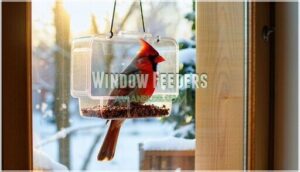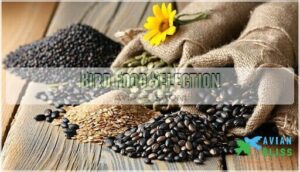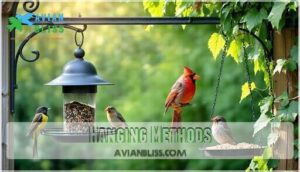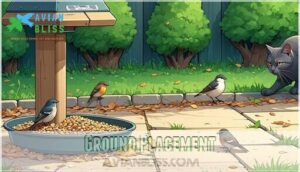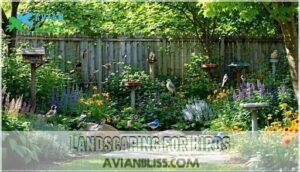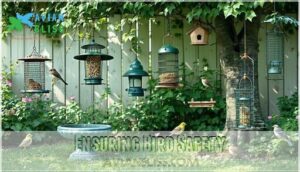This site is supported by our readers. We may earn a commission, at no cost to you, if you purchase through links.
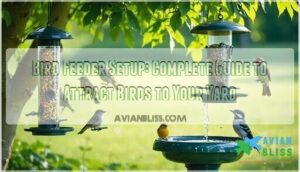 Your bird feeder setup doesn’t have to be rocket science. Start by placing feeders 10-12 feet from shrubs or trees—think of it as giving birds their own security blanket.
Your bird feeder setup doesn’t have to be rocket science. Start by placing feeders 10-12 feet from shrubs or trees—think of it as giving birds their own security blanket.
Choose tube feeders for songbirds and suet feeders for woodpeckers. Fill them with quality seeds, not cheap filler that’s like junk food for birds.
Position feeders where you can see them from inside but away from windows to prevent crashes. Add a water source nearby because birds get thirsty too.
Clean feeders monthly to keep your feathered friends healthy. The real magic happens when you understand what different species actually crave.
Table Of Contents
- Key Takeaways
- Choosing Feeder Location
- Selecting Feeder Types
- Bird Food Selection
- Feeder Installation Tips
- Providing Water Sources
- Maintaining Feeders
- Landscaping for Birds
- Ensuring Bird Safety
- Frequently Asked Questions (FAQs)
- What is the 5 7 9 rule for bird feeders?
- What is the best way to set up a bird feeder?
- Can you just throw bird seed on the ground?
- What is best to put under bird feeders?
- How do you set up a bird feeder?
- Do birds like feeders high or low?
- Should bird feeders be in the sun or shade?
- How far should a bird feeder be from a house?
- How often should feeders be cleaned?
- What attracts nuisance birds and pests?
- Conclusion
Key Takeaways
- Position your feeders strategically – Place them 10-12 feet from shrubs for bird safety, within 3 feet of windows or beyond 10 feet to prevent collisions, and choose spots with natural shelter nearby.
- Select quality food and appropriate feeders – Skip cheap seed mixes with fillers and choose black oil sunflower seeds as your main ingredient; match feeder types to target species (tube feeders for songbirds, suet feeders for woodpeckers).
- Add water sources and maintain cleanliness – Include a birdbath or dripper to attract twice as many birds, and clean your feeders every two weeks with soapy water to prevent mold and bacteria.
- Create a bird-friendly landscape – Plant native species that provide natural food and shelter, avoid using pesticides or chemicals near feeding areas, and include layered vegetation from ground cover to tall trees.
Choosing Feeder Location
You wouldn’t put your dining table in the middle of an empty parking lot, and birds feel the same way about open spaces.
Birds crave the same cozy comfort we do – they’ll skip the feeder that feels like eating in a fishbowl.
Place your feeders near trees or shrubs where birds can quickly escape from cats and hawks while still having clear flight paths to safety.
Proximity to Nature
Birds feel most at home when your feeder setup mimics their natural habitat. Think of it as creating a backyard café they’d actually want to visit.
Place feeders near trees and shrubs for instant natural shelters and predator avoidance.
- Native Flora: Choose local plants that birds recognize
- Habitat Integration: Blend feeders into existing landscape features
- Ecosystem Balance: Create connections between feeding and nesting areas
- Landscaping: Add bushes within 10-12 feet for quick escape routes
Avoiding Open Areas
Empty yards make birds feel like sitting ducks.
Without trees or shrubs nearby, your feeder location becomes a predator’s buffet table.
Birds need quick escape routes when hawks appear overhead.
Open areas offer zero wind protection and create uncomfortable sun exposure.
Smart birds skip feeders in barren spaces where predator visibility works against them, not for them.
Sheltered Locations
Weather can turn your feeder into a soggy mess or frozen disaster.
Smart feeder placement means finding spots that offer natural shelter from harsh elements while keeping birds comfortable year-round.
Consider these shelter priorities for ideal feeder placement:
- Snow Protection – Position feeders under roof overhangs or dense tree canopies
- Rain Shelters – Use natural wind breaks like fences or shrubs
- Sun Exposure – Balance shade with visibility for retreat from predators
Decorative Placement
Your feeder placement can transform your yard into a stunning focal point that brings joy to both you and your feathered visitors. Consider themed feeders that complement your garden’s aesthetic appeal – copper styles for rustic charm or sleek modern designs for contemporary spaces.
To guarantee bird safety, consider safe distances from windows.
| Feeder Style | Best Garden Integration |
|---|---|
| Copper/Bronze | Rustic, cottage gardens |
| Modern Steel | Contemporary landscapes |
| Wooden Crafted | Natural, woodland themes |
| Decorative Iron | Formal garden settings |
| Colorful Ceramic | Playful, eclectic yards |
The choice of feeder style can significantly impact the overall look and feel of your garden, making it a stunning focal point that enhances your outdoor space.
Selecting Feeder Types
You’ll need to match your feeder type to the birds you want to attract since different species prefer different feeding styles.
Think of it like choosing the right restaurant for your guests – cardinals love platform feeders while finches prefer tube feeders with small perches.
Tube Feeders
Classic tube feeders work like bird vending machines with transparent, waterproof containers protecting your bird seed from weather.
You’ll find different tube feeder types with varying seed capacity – some hold sunflower seeds while others dispense nyjer for finches.
Look for weather resistance and consider squirrel baffles. Many prefer classic feeder designs for ease of use.
Plan on cleaning frequency every two weeks for ideal bird feeder setup.
Suet Feeders
Suet feeders bring high-energy nutrition straight to your backyard friends.
These wire mesh cages hold rendered fat blocks that woodpeckers absolutely love. You’ll attract nuthatches, chickadees, and wrens too.
DIY suet recipes work great – mix peanut butter with seeds. Consider browsing different suet feeder options for your yard.
For squirrel proofing, choose caged designs or hang feeders from thin branches they can’t reach.
Window Feeders
Plastic window feeders stick directly to your glass using suction cups, bringing birds within arm’s reach for incredible viewing pleasure.
Their proximity to home offers unmatched bird visibility, though suction strength can fail during storms.
These feeders require frequent refilling but provide excellent squirrel proofing since they’re mounted high.
Many people buy window bird feeders online for convenience.
Window placement enhances aesthetic appeal while creating intimate backyard moments.
Bird Food Selection
You’ll want to skip those cheap seed mixes filled with milo and wheat that most birds won’t touch.
Instead, choose quality blends with black oil sunflower seeds as the main ingredient to attract cardinals, finches, and chickadees to your yard.
Seed Mixes
Quality birdseed mix makes all the difference between an empty yard and a bustling bird buffet.
You’ll want sunflower seeds and safflower seeds as your main ingredients – they’re like candy to most birds. Skip cheap mixes loaded with milo and wheat that birds ignore.
Here’s what attracts the most birds:
- Sunflower Seeds – Black oil variety brings cardinals, chickadees, and finches
- Safflower Seeds – Cardinals love these while squirrels typically avoid them
- Nyjer Seed – Goldfinches and siskins can’t resist these tiny black seeds
- Peanut Options – Woodpeckers and nuthatches go crazy for whole or chopped peanuts
Suet Varieties
Beyond basic bird food, suet opens doors to incredible backyard diversity. This high-energy treat attracts woodpeckers, nuthatches, and chickadees year-round.
Different varieties serve specific purposes—no-melt formulas work perfectly during summer heat, while hot pepper suet keeps persistent squirrels away. Choose quality suet with natural ingredients for fresh food that truly nourishes your feathered friends.
**Cage suet feeders are a popular, versatile option for attracting a variety of birds.
| Suet Type | Best For |
|---|---|
| No-Melt Suet | Hot summer days and sunny locations |
| Hot Pepper Suet | Deterring squirrels while attracting birds |
| SuperSuet | High-protein winter bird feeding needs |
| Simply Suet | Reducing blackbird and squirrel visits |
| Nuts & Berries | Attracting nut and fruit-eating species |
Nectar Solutions
Hummingbird feeders need proper nectar to keep your tiny visitors coming back.
Mix one part white sugar with four parts water for perfect sugar concentration.
Here’s what makes nectar irresistible:
- Fresh homemade recipes beat store-bought alternatives every time
- Clean feeders weekly preventing fermentation that harms birds
- Skip red dyes – your feeder’s color attracts them naturally
Change nectar every few days in hot weather.
Avoiding Cheap Fillers
Skip the bargain birdseed mix filled with milo, wheat, and millet that birds toss aside like yesterday’s leftovers.
These cheap fillers create wasteful mess under your feeders while attracting unwanted pests.
Instead, invest in quality wild bird seed with sunflower seeds as the first ingredient, which will make your feathered friends thank you, and your wallet won’t suffer from constant refills due to the lack of cheap fillers and the presence of sunflower seeds.
Feeder Installation Tips
You’ve picked the perfect spot and chosen your feeder, but now comes the fun part that makes or breaks your bird-watching dreams.
Getting your feeder properly installed means considering hanging methods, pole systems, and placement options that’ll keep both you and your feathered friends happy for years to come.
This process involves thinking about the overall experience, ensuring that the installation is done in a way that supports your bird-watching dreams.
Hanging Methods
You’ve picked the perfect bird food – now let’s get those feeders hanging!
Choose sturdy materials like metal shepherd hooks or decorative systems for lasting support.
Vary your hook heights to create visual interest and accommodate different bird species.
Deck mount brackets work great for railings, while yard poles offer flexibility.
A trellis support adds charm to your bird feeder installation, and with the right setup, you can create a lasting support for your bird feeders.
Pole Systems
In the context of bird feeder poles, you’ll want systems that offer rock-solid pole stability and serious squirrel baffles.
Advanced pole systems provide multiple mounting options while supporting impressive feeder capacity.
Look for weather resistance features like rust-proof coatings and heavy-duty steel construction.
A quality squirrel proof feeder setup with a reliable squirrel stopper pole makes squirrelproofing effortless and effective.
These setups often include an extension pole option for added height.
Ground Placement
Ground feeders work best on natural ground with good drainage solutions to prevent soggy seeds.
Place these low feeders near shrubs but not too close—you’ll want birds to spot predators easily.
Seed spillage attracts ground-feeding birds like juncos and sparrows.
Watch for predator concerns though. Cats love hunting near ground feeders, so keep them visible and accessible for quick escapes.
Window Placement
Window feeders offer unmatched viewing pleasure but require careful bird feeder placement for window safety.
Position your feeder within three feet of glass or beyond ten feet to prevent deadly collisions.
This distance guarantees collision prevention while maintaining bird visibility, as close placement reduces strike momentum, while distant positioning gives birds time to recognize and avoid the barrier.
You can also install squirrel guards to protect your feeders and ensure window safety.
Providing Water Sources
Water acts like a magnet for birds since every species needs it for drinking and bathing.
You’ll attract twice as many birds by adding a simple birdbath or dripper to your setup because water draws in species that won’t visit your feeders.
Bird Baths
A bird bath acts as your yard’s watering hole, drawing feeder and non-feeder birds alike.
Choose sturdy bath materials like ceramic or stone for durability.
Proper bath placement means positioning your water source at least 10 feet from bushes where cats lurk.
Fresh water and regular birdbath cleaning prevent bacterial growth.
Winter baths with heaters keep water unfrozen year-round.
Misters and Drippers
Adding misters and drippers transforms your bird bath into a magnet for feathered friends.
These water source systems create gentle sounds and movement that birds find irresistible.
Place your mister near existing bird baths for maximum bird attraction.
Different system types offer various flow rates. Regular dripper maintenance keeps freshwater flowing smoothly, ensuring your birdbath cleaning efforts pay off.
Heated Birdbaths
When winter’s chill threatens to freeze your feathered friends’ water source, heated birdbaths become lifesavers.
These energy-efficient units prevent ice formation while maintaining safe temperatures for birds.
You’ll find options with built-in thermostats that control energy consumption automatically, and choosing durable birdbath materials like stone or metal that work well with heating elements, ensures reliable winter hydration for visiting birds.
Shaded Birdbaths
Your bird bath’s location makes all the difference in creating a comfortable water source.
Shaded spots keep water cooler and prevent algae growth that turns your pristine basin into green soup.
Trees or shrubs provide natural cover while maintaining the ideal bird feeder environment.
Cool water attracts more birds and requires less frequent cleaning, making your backyard oasis truly irresistible.
Consider a shallow ground design to attract a wider variety of birds, creating a backyard oasis.
Maintaining Feeders
Clean feeders aren’t just about looking good – they’re about keeping your feathered friends healthy and happy.
A dirty feeder is like serving dinner on unwashed plates – your birds deserve better.
You’ll need to scrub them regularly and replace old food to prevent mold and bacteria that can make birds sick, which is a complete concept in maintaining their health.
Cleaning Feeders
Fresh water keeps birds healthy, but dirty feeders can make them sick. Regular bird feeder cleaning prevents mold and spoilage that harm your feathered friends. Think of it like washing dishes – you wouldn’t eat from dirty plates, and birds deserve the same courtesy.
Here’s your bird feeder hygiene checklist:
- Clean every two weeks – More often in hot, humid weather when mold grows faster
- Use mild detergent – Dish soap works perfectly; avoid harsh chemicals that could poison birds
- Scrub thoroughly – Get into all crevices where old seeds hide and bacteria multiply
- Rinse completely – No soap residue should remain on any surface birds will touch
- Air dry fully – Moisture creates perfect conditions for dangerous mold growth
Safe disposal of old, moldy food protects birds from getting sick. Your cleaning frequency directly impacts bird feeder maintenance success. Remember, clean feeders mean healthy birds!
Refilling Feeders
Keep your feeders topped off but don’t overfill them.
Check refill frequency every few days during peak seasons when birds devour seeds quickly.
Store birdseed in airtight containers to maintain freshness.
Fill feeders only two-thirds full to prevent spillage control issues and waste reduction.
Winter demands more frequent refills as birds need extra energy.
Monitor nectar levels in hummingbird feeders daily during summer months.
Replacing Food
Birds won’t visit feeders filled with stale birdseed. Replace food every two weeks or when it looks moldy, wet, or smells off.
Food freshness matters more than you think – old seeds lose their nutritional punch and can make birds sick.
- Toss nectar after three days in hot weather to prevent fermentation
- Store extra birdseed in airtight containers to maintain freshness
- Watch for seasonal changes that affect how quickly food spoils
Preventing Spoilage
Spoiled bird food turns your backyard buffet into a health hazard.
Store seeds in airtight containers away from moisture and heat.
Regular cleaning prevents mold growth that makes birds sick.
Check feeders weekly for clumped or discolored food.
Proper storage and humidity control keep seeds fresh longer.
To maintain a healthy environment, sanitize feeders regularly.
Clean feeders protect your feathered friends from harmful bacteria and mold.
Landscaping for Birds
Your yard’s landscaping matters just as much as your feeders in regard to attracting birds.
Think of native plants and shrubs as nature’s hotels – they provide shelter, nesting spots, and natural food sources that turn your space into a bird paradise.
Native Plants
Your backyard bird feeding success depends on more than just feeders.
Native plants create the foundation for attracting birds naturally. These local species support your ecosystem by hosting insects and producing seeds that birds crave.
Native plants like oaks and willows draw warblers while reducing lawn size.
They’re drought-tolerant and attract pollinators, making your landscaping work double-duty for wildlife.
Shelter and Nesting Sites
Setting up shelter and nesting sites turns your yard into a bird paradise.
Different bird species preferences require various roosting spots and cavity nesters need specific homes.
Create these essential features:
- Nesting boxes – Install appropriate sizes for target species
- Brush piles – Stack natural materials like branches and leaves
- Dense shrubs – Provide safe backyard bird feeding areas
This shelter attracts more birds than feeders alone.
Avoiding Gardens With Insecticides
Creating safe shelters means keeping harmful chemicals away from your bird feeding environment.
Chemical pesticides pose serious threats to bird health and can contaminate their food sources.
Smart gardeners choose organic methods that protect both plants and wildlife.
| Harmful Practice | Bird-Safe Alternative |
|---|---|
| Chemical insecticides | Companion planting with marigolds |
| Synthetic fertilizers | Compost and organic matter |
| Toxic slug pellets | Copper barriers and beer traps |
Your feeder location should stay far from treated areas for ideal bird feeding safety.
Creating a Bird-Friendly Environment
Beyond keeping chemicals away from your feeders, transforming your yard into a true Safe Havens for birds requires thoughtful planning.
Think of your space as a bird’s dream neighborhood where they’ll want to raise families and return year after year.
Here’s how to create the perfect bird feeding environment:
- Plant native flowers and shrubs that provide Natural Diet options like berries, seeds, and insects
- Leave dead branches and twigs as Nesting Materials and natural bird perching areas
- Create layered vegetation from ground cover to tall trees for Bird Diversity and bird shelter
- Maintain Toxic Free zones by avoiding pesticides and providing safe space for predator prevention
Ensuring Bird Safety
You’ve created a backyard bird paradise, but now you need to protect your feathered visitors from common dangers like window strikes and prowling cats.
Smart feeder placement and simple safety measures will keep birds safe while they enjoy their meals at your feeding station.
Collision Prevention
Window strikes kill millions of birds yearly, but simple fixes work wonders.
Position your feeders within three feet of windows or beyond ten feet to reduce collision momentum.
Apply window film or visual markers like decals to glass surfaces. Choose frosted or patterned glass for new installations.
These bird feeder safety measures prevent most window strikes effectively.
Predator Protection
Your feeder’s location can make or break bird safety.
Keep feeders at least 10 feet from dense bushes where cats lurk. Position them high enough for quick hawk evasion – think second-story height.
Install squirrel baffles below pole-mounted feeders to block climbing predators. Place shelter like shrubs nearby but not too close.
Smart placement turns your yard into a safe haven.
Window Strike Risks
Glass becomes invisible death traps for birds during your bird feeder setup.
Position feeders within three feet of windows or beyond ten feet to prevent fatal bird feeder window strikes.
Window film and decal solutions create visible glass patterns that dramatically improve bird feeder bird safety.
Strategic bird feeder location with proper lighting effects helps birds recognize barriers while maintaining ideal bird feeder bird attraction and overall safety.
Squirrel and Cat Deterrence
You’re fighting a backyard battle against furry bandits and prowling predators.
Install squirrel deterrents like baffles on poles and choose cage design feeders that block access. Keep feeder height at least five feet with proper baffle placement.
Motion sprinklers startle cats effectively. Deterrent foods with cayenne pepper discourage squirrels without harming birds.
Victory requires strategic planning.
Frequently Asked Questions (FAQs)
What is the 5 7 9 rule for bird feeders?
Like a well-choreographed dance, the 5-7-9 rule keeps your feathered friends safe.
You’ll place feeders within 5 feet of cover, 7-10 feet from windows, and 9+ feet from launching spots where cats prowl.
What is the best way to set up a bird feeder?
Choose a spot near trees but 10-12 feet away for safety.
Place feeders within 3 feet of windows or farther than 10 feet to prevent collisions.
Fill with quality sunflower seeds and add fresh water nearby.
Can you just throw bird seed on the ground?
Surprisingly, many birds actually prefer ground feeding!
You can scatter seed on the ground, but use platform feeders instead.
They’ll protect seeds from moisture, pests, and waste while attracting ground-feeding birds safely.
What is best to put under bird feeders?
Place a catch tray, ground cloth, or layer of mulch underneath your feeders.
This prevents scattered seeds from sprouting weeds, keeps your yard tidy, and gives ground-feeding birds a clean dining spot.
How do you set up a bird feeder?
Start by selecting a durable feeder and mounting it 10-12 feet from trees.
Fill with quality seeds like black oil sunflower.
Position near shelter but away from predators.
Add fresh water nearby.
Do birds like feeders high or low?
Birds aren’t particularly picky about elevation, but they’ll feel more secure with feeders positioned at medium heights.
You’ll want to place them 5-8 feet high—close enough for easy refilling yet high enough to discourage ground predators.
Should bird feeders be in the sun or shade?
You’ll want to place your feeders in bright, open areas for best visibility.
Birds need quick escape routes from predators.
However, consider partial shade in scorching climates to keep seeds fresh longer.
How far should a bird feeder be from a house?
Think you’re being sneaky placing feeders right against your house? You’ll create a bird traffic jam! Position feeders 10-12 feet from your home for ideal safety and viewing pleasure.
How often should feeders be cleaned?
Clean your feeders every two weeks with hot, soapy water and rinse thoroughly. During wet weather or heavy use, clean weekly to prevent mold and bacteria that can harm birds.
What attracts nuisance birds and pests?
You’re opening Pandora’s box when cheap seed mixes with milo and fillers attract starlings, grackles, and squirrels.
Scattered seeds on the ground also invite rodents and raccoons to your feeding station.
Conclusion
Ready to transform your yard into a bustling bird paradise? Your perfect bird feeder setup combines smart placement, quality food, and regular maintenance.
Position feeders near natural shelter, choose species-appropriate designs, and maintain clean feeding stations.
Add fresh water sources and native plants to create an irresistible habitat. Remember, patience pays off—birds need time to discover and trust new feeding areas.
Soon you’ll enjoy daily visits from colorful songbirds, busy woodpeckers, and other feathered neighbors right outside your window, creating a wonderful bird feeder setup.
- https://biodiversity.utexas.edu/news/entry/pets-as-invasive-species-cats
- https://jcswildlife.com/squirrel-stopper-deluxe-squirrel-proof-bird-feeder-pole-system-with-baffle/?ref=hVhUWmk6vKk1IL
- https://www.britannica.com/animal/bird-animal/Importance-to-man
- https://cleaning.lovetoknow.com/outdoor-cleaning/how-clean-bird-bath-keep-it-fresh



